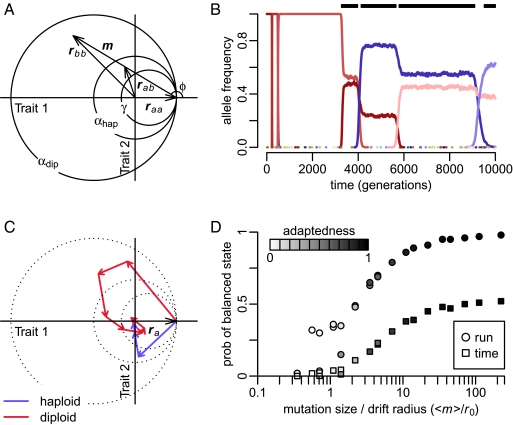Fig. 2.
Fisher's geometric model of adaptation in two dimensions. (A) Two orthogonal axes represent independent character traits. Fitness is determined by a symmetrical Gaussian function centered at the origin. Consider a population initially monomorphic for the wild-type allele raa = (2,0). A mutation m gives rise to a mutant phenotype vector rbb = raa + m. The phenotype of the mutant heterozygote assuming phenotypic codominance (h = 1/2) is rab = raa + m/2. The different circles specify the areas in which mutations are adaptive in haploids (αhap), adaptive in diploids (αdip), and replacing in diploids (γ). (B) Frequency trajectories of all alleles present during a representative adaptive walk in a diploid population with N = 5⋅104, raa = (2,0), and <m> = σw = 1. Different colors represent different alleles. The black bars over the graph indicate the periods during which a balanced polymorphism was present. (C) Representative adaptive walks in a haploid population and a diploid population. Vectors depict the successive mutations that led to the prevalent allele at the end of the walk. The haploid walk consists of a single lineage of successive mutations, each conferring a selective advantage over the previous one. In the diploid walk, the first mutation overshoots the fitness optimum, generating a sequence of intermediate balanced states. Note that the areas αhap, αdip, and γ (dotted circles) from A apply only to the first mutation in the walk when the population is still monomorphic for ra. (D) Probability of observing balanced polymorphism during adaptive walks toward a fixed fitness optimum as a function of mutation sizes scaled by effective drift radius r0 (SI Text) for the various settings of N, σw, and <m> specified in Table S1. Circles show the probability of at least one balanced state arising over the course of a walk, and squares show the fraction of time during which balanced states were present. Coloration indicates the average “adaptedness” achieved during a walk, defined by the improvement in mean population fitness over the walk (<wend> − <wstart>) relative to the maximally possible improvement (1 − <wstart>).

